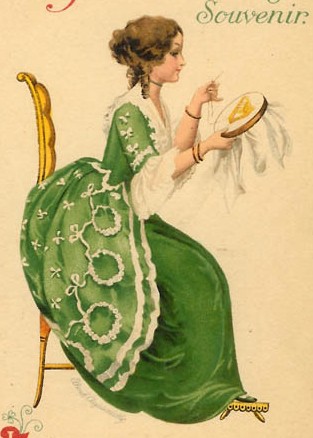 A Navajo legend credits a deity named Spider Woman with teaching them weaving. The first loom was said to be of sky and earth cords with tools of sunlight, lightning, white shell, and crystal. In reality, Pueblo Indians taught the Navajos how to weave.
A Navajo legend credits a deity named Spider Woman with teaching them weaving. The first loom was said to be of sky and earth cords with tools of sunlight, lightning, white shell, and crystal. In reality, Pueblo Indians taught the Navajos how to weave.The Pueblo people of Northern New Mexico were cultivating cotton around 1300 AD, which they used for weaving. They practiced finger weaving, and had also learned the use of the backstrap loom from Mexican Indian tribes. Weaving was a man's activity in most pueblos. They wove in the kiva, or ceremonial room, a cramped space that inspired the invention of the upright loom. The arrival of the Spaniards and their Churro sheep in the 16th century led to a change from cotton to wool as weaving material for the Pueblo Indians as well as the Navajos, who learned the technique from their neighbors in the late 1600s. The Spanish also introduced indigo (blue) dye and simple stripe patterning.
Early Navajo weavers used wool, dyed with native, natural dyes, as well as a rewoven thread from Bayeta (bright red wool of flannel consistency from England). They unraveled other blankets and clothing and, by adding these materials to their own homespun wool, developed a beautiful variety of colors and styles.
The best-known example, reputedly the earliest Navajo weaving still in existence, is the “Massacre Cave Blanket” from Canyon de Chelly. This all-wool blanket, frequently dated at 1804, was recovered from the ruins of the massacre. It features all-natural dyes, medium and dark brown and beige on white. This blanket is regarded as marking the end of the Early Weaving or Early Classic period; it is often cited as marking the beginning of the Classic Period.
The best-known example, reputedly the earliest Navajo weaving still in existence, is the “Massacre Cave Blanket” from Canyon de Chelly. This all-wool blanket, frequently dated at 1804, was recovered from the ruins of the massacre. It features all-natural dyes, medium and dark brown and beige on white. This blanket is regarded as marking the end of the Early Weaving or Early Classic period; it is often cited as marking the beginning of the Classic Period.
_________________________________________
Yá'át'ééh or Yah-Ta-Hey (Anglo pronunciation) is Navajo for 'hello." We lived for many years in the Four Corners area (New Mexico, Colorado, Arizona, and Utah) and I have great respect and love for the Navajos.
The Navajo language has not only helped to preserve the Navajo culture but was also utilized as a U.S. Army code to disguise transmissions from the Japanese during World War II. These Navajos were called "Code Talkers." http://www.history.navy.mil/faqs/faq61-2.htm
The Navajo call themselves Dineh and together with the Apache, constitute the southern branch of the Athapascan linguistic family, living in New Mexico, Arizona, western Texas, southeastern Colorado, Utah, and in northern Mexico. The earliest recorded mention of the Dineh (Navajo) is in 1629, when white settlers from Mexico moved among them. They are intensely religious.
___________________________
OHKWA'HO AKA'RA
Dineh (Navajo) Wind Prayer
by Wolfeyes
Oh, Great Spirit, Oh Grandfathers, How lucky can one be to know such beauty? One can search the world over And not find this much loveliness.
Dineh (Navajo) Wind Prayer
by Wolfeyes
Oh, Great Spirit, Oh Grandfathers, How lucky can one be to know such beauty? One can search the world over And not find this much loveliness.


No comments:
Post a Comment